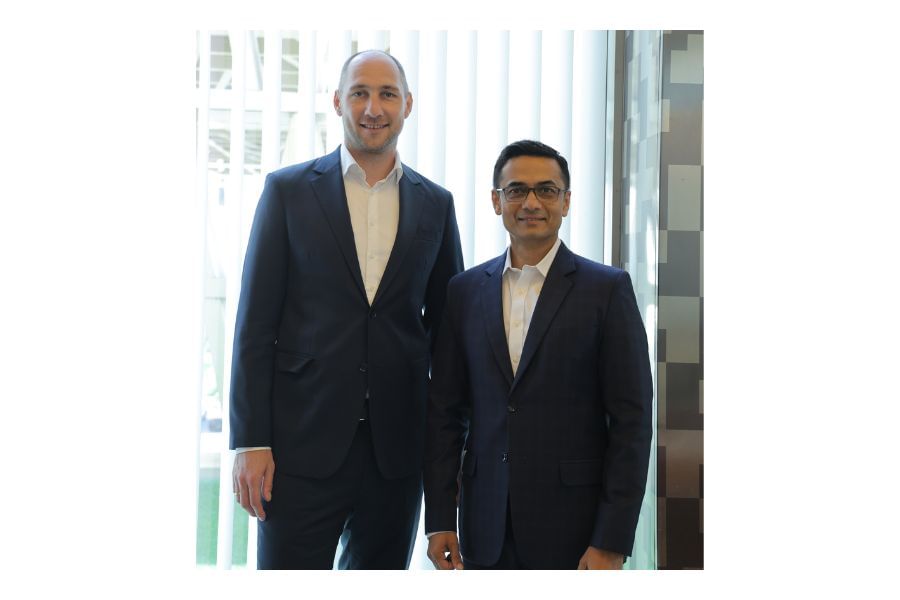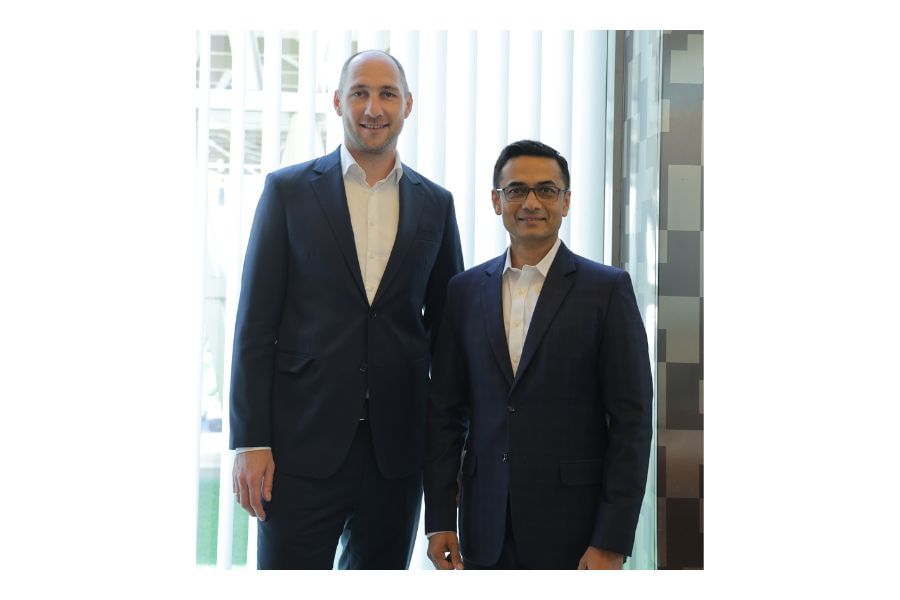The German materials and chemicals company, BASF, which is a leading after-treatment catalyst supplier to automotive OEMs and Tier-1s in India, is committed to and confident about offering tailored solutions for the needs of the Indian market. The company, which has recently invested in a new R&D and Application (RD&A) lab at its manufacturing facility in Chennai, is ready to continue investing in capacity to cater to the growing demand from the Indian market.
In this conversation, Sujan Saha – MD, BASF Catalysts India and Head of Southeast Asia, Mobile Emissions Catalysts, and Daniel Wussow, SVP, Mobile Emissions Catalysts, BASF Environmental Catalyst and Metal Solutions, share their insights on the tightening emission standards for ICE vehicles and their impact on after-treatment systems. Excerpts:

What are the key BASF ECMS products aimed at the automotive sector?
Daniel: For the BASF Environmental Catalyst and Metal Solutions (ECMS) division, our core expertise lies in a number of areas. First is catalysis, where we have an exceptional know-how in coating technologies, catalyst design, and platinum group metals (PGMs) control, which allows us to deliver sustainable technologies and protect the air we breathe.
Next is precious metal services, where we manage the full metals loop for a circular economy. This includes trading and risk management for PGMs, physical inventory and supply chain management, and helping customers with procurement and sales.
Third is precious metal products and recycling, where we recover and re-introduce PGMs into the market, closing the loop sustainably. We also offer solutions for both the beginning and end of the hydrogen value chain – the production of green hydrogen using electrolysers and the use of hydrogen in fuel cells.
What challenges do automotive companies face amidst constantly evolving emission regulations?
Daniel: As emission norms tighten, automakers face mounting challenges. For one there is an increase in the technological complexities, for instance, with the Bharat Stage 7 (BS-VII) and Corporate Average Fuel Efficiency-3 (CAFE-III) regulation upgrades, there will be a requirement for advanced catalysts, engine upgrades, and new materials without compromising performance. Cost pressures further add to the strain as compliance technologies on one hand increase vehicle prices, whereas the supply chain volatility in PGMs complicates planning.
Moreover, adapting global standards to India’s fuel quality, driving conditions, and climate demands localised solutions, while the shift to new powertrains like hybrids and hydrogen stretches RD&A efforts further. On top of this, regulatory uncertainty forces companies to keep manufacturing and rollouts flexible.
How is BASF gearing up to cater to the industry’s needs to meet the upcoming CAFE-III and BS-VII emission standards?
Sujan: The CAFE-III norms would mean that OEMs will recalibrate their engines and implement new engine technologies to optimise fuel consumption and CO2 requirements. This could lead to lower engine-out temperatures and revised emission conversion efficiency requirements. BASF is working with all our customers to optimise the catalyst layout, technology and the PGMs content to meet the revised requirements.
With respect to BS-VII norms, there is little clarity still regarding the timeline related to the notification in India, however based on our significant success with the Euro-7 emission compliance in Europe, we are very committed to and confident about meeting the market requirements in India.
What cost impact is anticipated with the shift from BS-VI to BS-VII emission norms?
Sujan: BS-VII regulations for all vehicles could mean the layout of the after-treatment system gets changed – a particulate filter may need to be introduced in vehicles, along with changes in the engine calibration, and additional sensors, among other things. While this may have an impact on the cost, the increase would likely be nominal and much lower than the change historically witnessed when going from BS-IV to BS-VI norms in diesel systems.
What is the company’s investment roadmap toward its solutions for these norms?
Daniel: We have significantly invested in CapEx, both on the four-wheeler and two-wheeler fronts, over the last few years, and we continue to look into making further investments to increase capacity. We are the only player in the Indian market with localised RD&A and are working closely with our customers. For us, it is important that India gets to play a key role in the global scale, and we want to support that transition. We will be ready with CapEx and R&D to support the transition to BS-VII emission norms across vehicle segments.
How is BASF ECMS placed in terms of its local manufacturing and R&D footprints in India?
Sujan: Our manufacturing capability within automotive catalysts is the largest in India, and as we progress and anticipate the market growth, we are making further investments which will cater to the market beyond 2030, and even 2035. Therefore, BASF will be supporting the growth ambition of our customers with our local manufacturing setup in Chennai where we also have recently invested in an integrated RD&A centre.
We are bringing our global expertise across multiple locations to the local RD&A center in Chennai to support the domestic market and its specific needs such as that for CNG-based small vehicles and flex-fuel vehicles. The research efforts in India are currently focused on solving these India-specific problems.
What role do you see India play for emission control products globally in the coming years?
Daniel: India’s large ICE vehicle base makes it a key market and innovation hub for emission control technologies. With stricter regulations like BS-VII and CAFE-III norms, the demand for advanced catalysts, particulate filters, SCR systems, and other after-treatment solutions is set to rise sharply.
At the same time, India can play a strategic global role. Local RD&A and manufacturing facilities like our BASF ECMS operations in Chennai, where our RD&A laboratory allows us to tailor solutions for Indian fuels, driving cycles, and ambient conditions, can provide valuable insights that can be applied globally.
Additionally, India’s growing hybrid vehicle segment offers opportunities for integrated solutions across ICE, hybrid powertrains, bridging the transition to cleaner mobility. Therefore, India will not only be a major consumer but also a source of innovation and expertise for global emission control products, helping OEMs worldwide meet stricter environmental and regulatory demands.
Does BASF ECMS continue to invest in emission control solutions for diesel engines?
Daniel: While diesel’s reputation was damaged after the ‘Dieselgate’ episode in Europe a decade ago, it plays a major role in heavy-duty applications. Diesel is still alive, and it will be here for quite a while. As BASF ECMS, we remain neutral to all fuel types and continue investing in after-treatment solutions for diesel engines.
Compared to our competitors, we have an ‘against-the-trend’ strategy, wherein we tend to go the opposite way as we believe it is important to be stronger for longer. We want to be there for our customers, and we want to be the one to produce the last catalyst if that ever happens at all.
How does BASF view the impact of the transition to zero-emission vehicles on its mobility catalysts business?
Daniel: While ICE vehicles will remain significant for the next decade, stricter norms like the BS-VII regulations and government incentives will drive cleaner mobility. Our experience in catalysis and precious metal management positions us well to provide solutions across ICE, hybrid, and hydrogen-based powertrains, ensuring a smooth transition for our customers.
For instance, BASF ECMS is actively developing catalysts and materials for fuel cells and electrolysers, enabling clean energy generation and mobility. In addition to electrolyser and fuel-cell applications, there are also technological synergies in the areas of catalyst development and production, coating processes and recycling concepts. ECMS is active in all these fields.
Furthermore, our peer divisions within BASF are also prepared for this shift by supplying advanced battery materials, thermal management and solutions that support efficient EV powertrains.
What is BASF’s market share in automotive emission catalysts and what is its ambition by 2030?
Sujan: Globally, BASF ECMS is the leader in the light-duty gasoline and heavy-duty diesel segments, and we intend to remain in the leading position. While we are currently second in the light-duty diesel segment, we will become number one with the implementation of Euro-7 regulations in Europe.
In India, we are the leading catalyst supplier both in gasoline and diesel platforms in the passenger as well as commercial vehicle segments. Our position is only getting stronger in the two-wheeler segment as well.
